Dish gardens offer creativity, tranquility, and natural beauty in compact spaces. You’ll discover how to transform simple containers into living works of art through eight distinct garden styles, from arid desert landscapes to lush tropical paradises. Each design brings its own unique character and maintenance requirements, allowing you to select the perfect miniature ecosystem for your space. Let’s explore how these tiny gardens can enhance your home or office with minimal effort and maximum impact.
Contents
Desert Oasis: Succulent and Cacti Arrangements
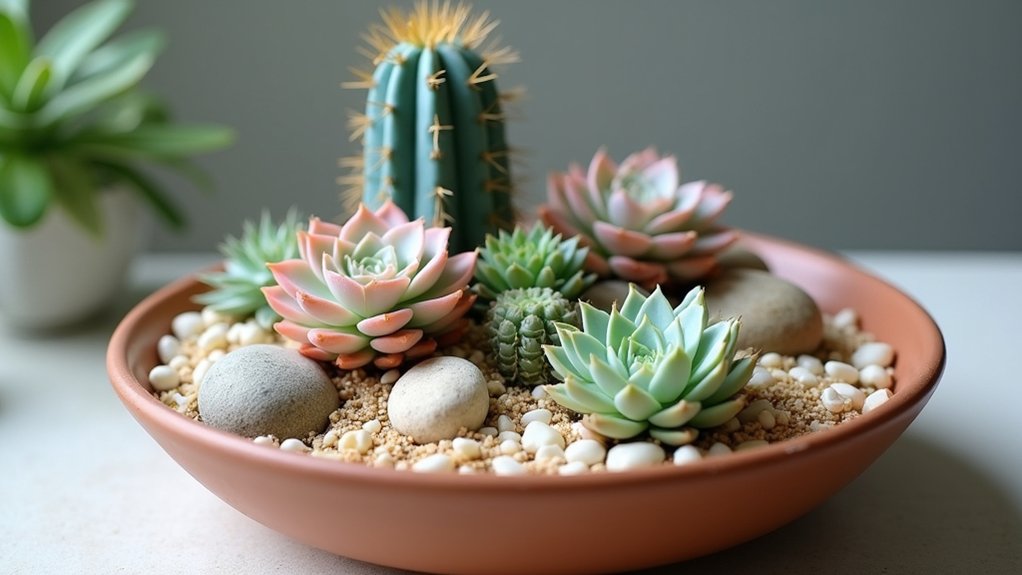
A desert oasis arrangement showcases a striking collection of succulents and cacti that mimics the natural beauty of arid landscapes in miniature form. These arrangements typically feature various shapes, sizes, and textures, from spiky barrel cacti to rosette-forming echeverias, creating a visually dynamic display.
When grouped together in shallow containers or dish gardens, these drought-tolerant plants create an exotic ecosystem that brings the essence of the desert into any space.
Growing Conditions:
- Light: Bright, direct sunlight for 6-8 hours daily; south or west-facing windows ideal
- Water: Allow soil to dry completely between waterings; reduce watering in winter
- Soil: Fast-draining cactus mix or regular potting soil mixed with sand and perlite
- Temperature: 60-80°F (15-27°C); protect from frost
- Humidity: Low humidity preferred; good air circulation essential
- Container: Must have drainage holes; shallow, wide containers work best
Regular maintenance focuses on preventing common issues that can affect desert arrangements. Remove any dead or yellowing leaves promptly to prevent rot, and rotate the container quarterly to ensure even growth.
Inspect plants monthly for signs of pests like mealybugs or spider mites, treating immediately with insecticidal soap if detected. Prune overcrowded areas to maintain aesthetic appeal and proper air circulation, and refresh the top layer of soil annually with fresh cactus mix to replenish nutrients.
Woodland Wonderland With Native Moss
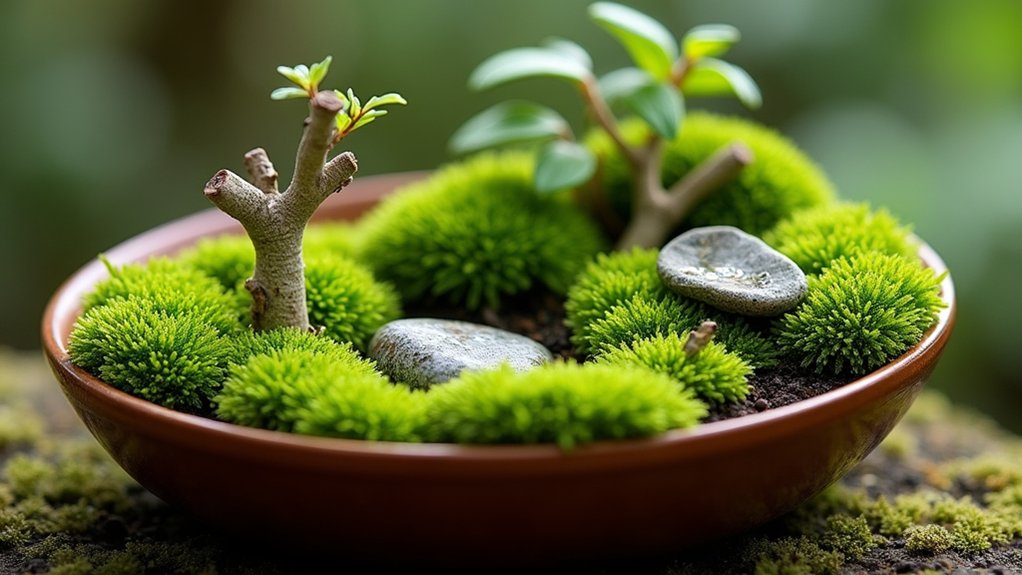
A woodland wonderland with native moss creates a lush, enchanting miniature landscape that captures the essence of a forest floor. This design features various species of moss as the primary groundcover, creating a soft, carpet-like appearance in vibrant shades of green.
Natural elements like small twigs, bark pieces, and tiny stones complete the woodland aesthetic, while miniature ferns or small native woodland plants can add vertical interest and dimension to the scene.
Growing Conditions:
- Indirect, filtered light – avoid direct sunlight
- High humidity levels (60-70%)
- Consistently moist but not waterlogged soil
- Well-draining, slightly acidic soil (pH 5.0-6.0)
- Temperature range of 60-70°F (15-21°C)
- Good air circulation while maintaining humidity
Regular misting and careful monitoring of moisture levels are essential for maintaining a healthy moss garden.
Remove any fallen debris promptly to prevent decay, and trim any browning portions with clean scissors. During active growing seasons, feed the moss garden with a highly diluted organic fertilizer solution every few weeks.
If any weeds appear, carefully remove them by hand to avoid disturbing the delicate moss structure. In outdoor settings, protect the garden from strong winds and heavy rain by placing it in a sheltered location.
Tropical Terrarium Paradise
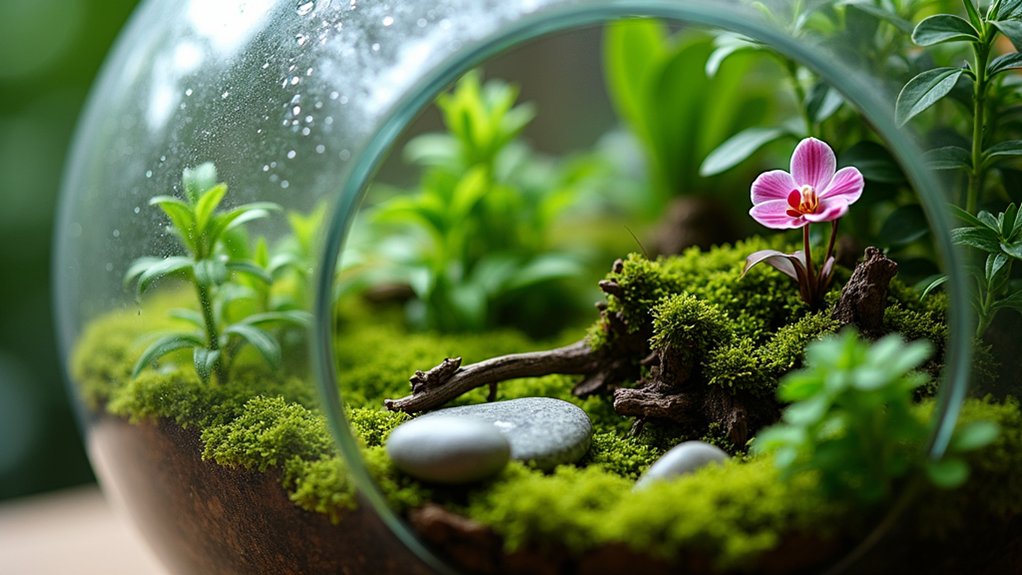
A tropical terrarium paradise transforms a glass container into a lush miniature rainforest ecosystem, featuring small tropical plants like ferns, moss, miniature orchids, and compact philodendrons.
These enclosed gardens recreate the humid, warm environment of tropical regions, with multiple layers of greenery creating depth and visual interest. The combination of different leaf textures, shapes, and shades of green, along with decorative elements like small stones or driftwood, creates a self-contained slice of jungle life.
Growing Conditions:
- Bright, indirect light – avoid direct sunlight which can overheat the terrarium
- Temperature between 70-85°F (21-29°C)
- High humidity levels (60-80%)
- Well-draining, nutrient-rich potting mix with added charcoal
- Container with a lid or partial cover to maintain humidity
- 2-3 inches of drainage material at the bottom (gravel or pebbles)
- Limited air circulation to maintain tropical conditions
Maintaining a tropical terrarium requires regular monitoring to prevent common issues like mold growth or bacterial problems.
Trim plants when they outgrow their space and remove any dead leaves promptly. Clean the glass walls periodically to maintain visibility and prevent algae buildup. If condensation becomes excessive, leave the lid partially open for short periods to allow some air exchange.
Fertilize sparingly with a diluted liquid fertilizer every few months during the growing season, as terrariums typically maintain a delicate nutrient balance.
Zen Garden With Mini Bamboo
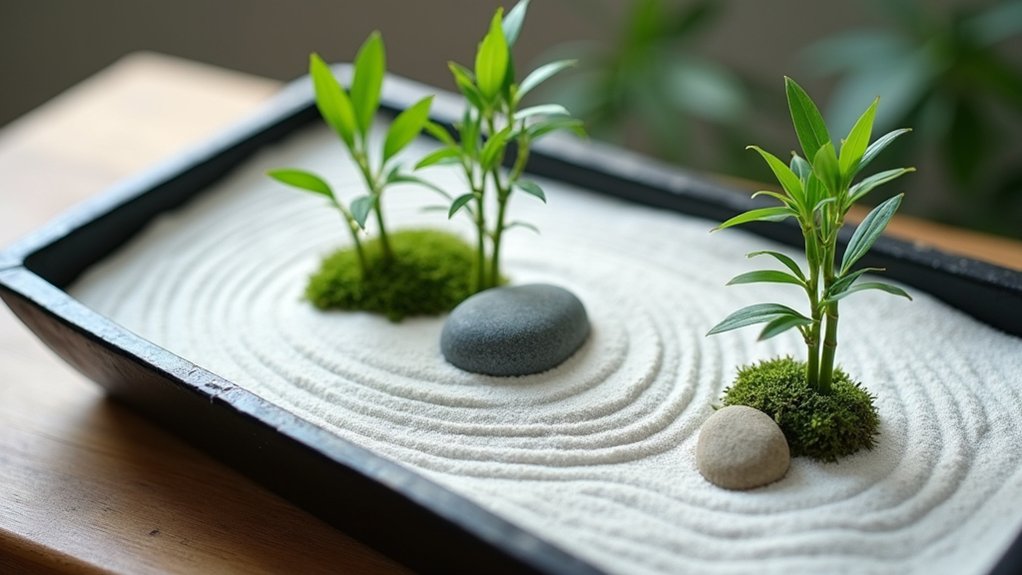
A miniature Zen garden featuring dwarf bamboo creates a serene, meditative space that embodies traditional Japanese aesthetics in a compact form. The arrangement typically includes small bamboo plants as focal points, complemented by carefully raked sand or fine gravel patterns, minimalist rock formations, and possibly tiny pagoda ornaments or moss elements.
The dwarf bamboo varieties used, such as Pleioblastus or Sasa species, maintain naturally small proportions while providing the characteristic vertical lines and gentle rustling movement associated with traditional bamboo gardens.
- Light Requirements: Bright, indirect sunlight; morning sun with afternoon shade ideal
- Water Needs: Consistent moisture without waterlogging; mist leaves regularly
- Soil Type: Well-draining, slightly acidic soil (pH 6.0-6.5)
- Humidity: Moderate to high (50-60%)
- Temperature: 65-75°F (18-24°C)
- Container: Shallow, wide container with drainage holes
- Growing Medium: Mix of potting soil, sand, and pebbles for stability
Regular pruning of yellowing leaves, controlling spread through root barrier maintenance, and periodic thinning of dense clusters keeps the mini bamboo healthy and proportionate to the garden’s scale.
Monthly applications of balanced, water-soluble fertilizer during growing season support steady growth, while periodic cleaning of decorative elements and raking of sand patterns maintains the garden’s aesthetic appeal.
Inspect regularly for signs of spider mites or mealybugs, especially in indoor settings where air circulation may be limited.
Fairy Garden With Blooming Miniatures
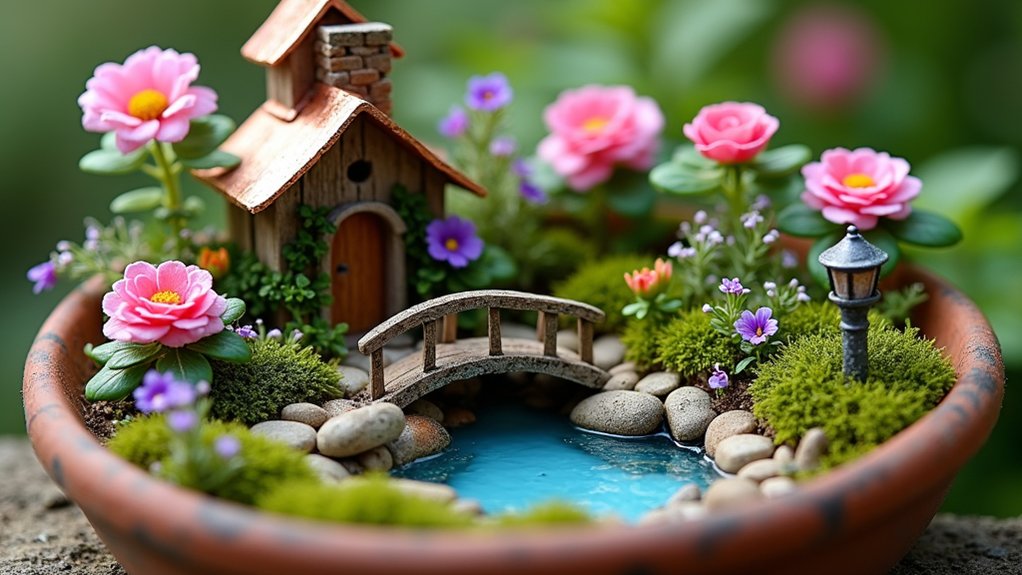
A fairy garden with blooming miniatures creates a whimsical, scaled-down landscape featuring tiny flowering plants that maintain proper proportions alongside decorative elements like miniature houses, paths, and fairy figurines.
These enchanted displays typically incorporate dwarf varieties of traditional flowering plants such as miniature roses, tiny violets, baby’s tears, and small-leafed creeping thyme, all working together to create a living dollhouse effect in a container or dedicated garden space.
- Light: Bright, indirect sunlight for most miniature flowering plants; morning sun with afternoon shade is ideal
- Water: Consistent moisture without waterlogging; water when top 1/2 inch of soil feels dry
- Soil: Well-draining, nutrient-rich potting mix with added perlite
- Temperature: 60-75°F (15-24°C) for optimal growth
- Container: Must have drainage holes and be proportionate to miniature design
- Spacing: Plants should be placed 2-3 inches apart to allow for minimal growth
Regular pruning and grooming are essential to maintain the miniature scale of a fairy garden with blooming miniatures.
Pinch back aggressive growers to prevent them from overwhelming smaller specimens, and promptly remove spent blooms to encourage continuous flowering.
Rotate the container every few days if growing indoors to ensure even growth, and inspect plants weekly for signs of pests or disease, which can quickly spread in the close plantings typical of fairy gardens.
Mediterranean Herb Garden Display
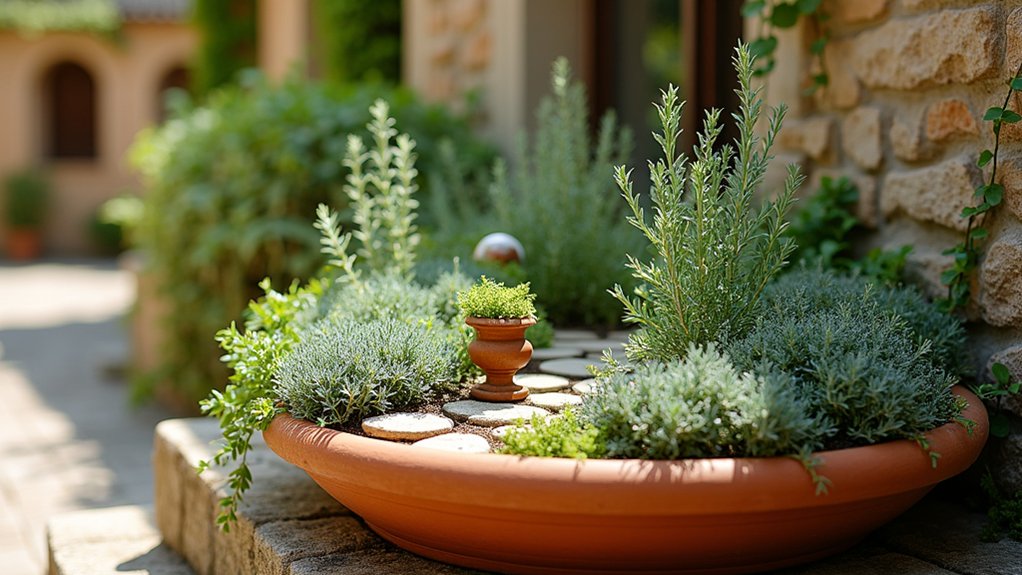
A Mediterranean herb garden display recreates the rustic charm of southern European landscapes in miniature form. This aromatic arrangement typically features classic herbs like rosemary, thyme, oregano, and sage planted in terracotta pots or a shallow, wide container with excellent drainage.
The plants create a textural tapestry of silver-green foliage, with varying heights and spreading habits that add visual interest while maintaining a compact footprint. Small decorative elements like miniature stone paths or tiny ceramic features can enhance the Mediterranean aesthetic.
Growing Conditions:
- Full sun exposure (6-8 hours daily)
- Well-draining, sandy soil with pH 6.0-7.0
- Low to moderate water needs; soil should dry between waterings
- Good air circulation around plants
- Temperature range of 65-80°F (18-27°C)
- Low humidity preferred
- Container must have drainage holes
Regular pruning is essential to maintain the compact shape and prevent woody growth in Mediterranean herbs. Trim back any flowering stems to encourage leaf production, and remove dead or yellowing foliage promptly.
Avoid over-fertilizing, as Mediterranean herbs develop better flavor in lean soil conditions. During winter months, reduce watering frequency and protect containers from frost by moving them to a sheltered location or closer to building walls.
Periodic root pruning and dividing every 2-3 years will help maintain plant vigor and prevent overcrowding.
Rock Garden With Alpine Plants
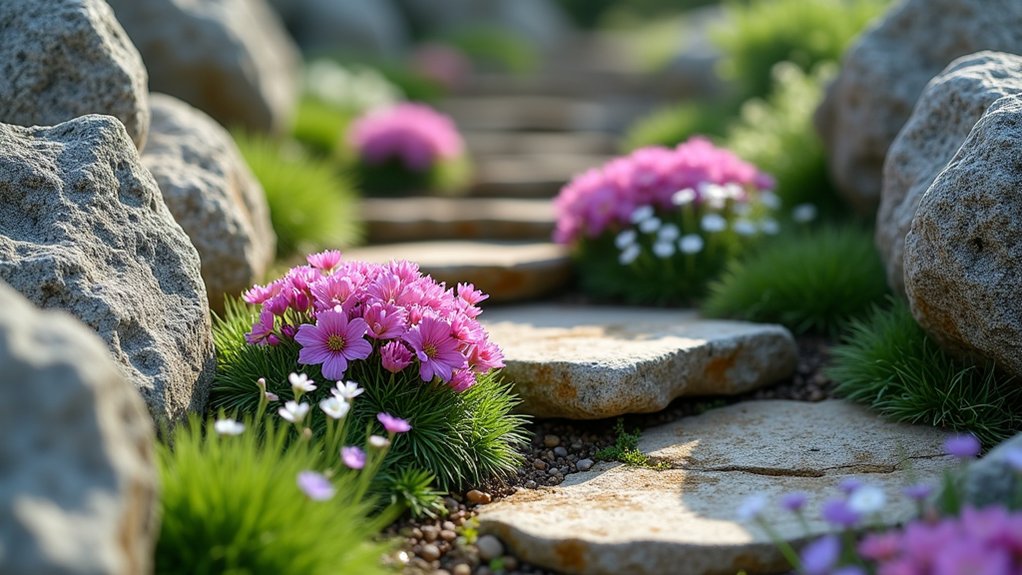
A rock garden with alpine plants creates a striking miniature landscape that mimics high-altitude mountain environments. These gardens feature small, low-growing plants nestled between carefully arranged rocks and stones, creating natural-looking crevices and slopes.
Alpine plants typically have compact growth habits, forming dense mats or cushions of foliage, often adorned with proportionally large, vibrant flowers that add stunning visual interest to the rocky terrain.
- Full sun to partial sun exposure (minimum 6 hours daily)
- Well-draining, gritty soil mixture with sand and small gravel
- Moderate watering, allowing soil to dry between waterings
- Good air circulation around plants
- pH level between 6.0-7.0
- Protection from excessive winter moisture
- Elevated planting area or slope for enhanced drainage
Regular maintenance of a rock garden with alpine plants focuses on preventing the spread of aggressive species and removing spent blooms to encourage repeat flowering.
Remove any fallen leaves or debris that could trap moisture and lead to rot. Spring cleaning should include checking for frost-heaved plants and resetting them in the soil, while adding fresh gravel or stone chips around plants helps maintain proper drainage and prevents soil splashing onto the foliage.
Trim back any dead growth and divide overcrowded plants every few years to maintain the garden’s scaled appearance.
Rainforest Scene With Ferns and Air Plants

A miniature rainforest scene featuring ferns and air plants creates a lush, tropical atmosphere in a compact space. The layered arrangement combines delicate fern fronds with suspended air plants to mimic the natural canopy levels found in tropical forests.
Small-growing fern varieties like button ferns or bird’s nest ferns form the understory, while Tillandsia air plants can be mounted on tiny branches or driftwood to create the illusion of epiphytes growing in their natural habitat.
Growing Conditions:
- Bright, indirect light – avoid direct sunlight which can burn leaves
- Humidity levels between 60-80%
- Temperature range of 65-80°F (18-27°C)
- Well-draining potting mix rich in organic matter for ferns
- No soil needed for air plants
- Good air circulation while maintaining humidity
Regular grooming and proper plant positioning are essential for maintaining this miniature ecosystem. Remove any yellowed or dead fronds from ferns, and rotate the container periodically to ensure even growth.
Air plants should be removed every 1-2 weeks for thorough misting or soaking, then allowed to dry completely upside down before returning them to their display position. Trim any damaged air plant leaves from the outer edges, and periodically check mounting materials to ensure they remain secure and free from decay.
